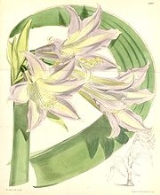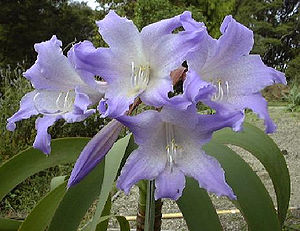
Worsleya
Encyclopedia

Amaryllidaceae
Amaryllidoideae is the subfamily of flowering plants that takes its name from the genus Amaryllis. It is part of the family Amaryllidaceae, in order Asparagales...
). Worsleya is a tropical plant. This species is also known as the empress of Brazil because of its origin in South America
South America
South America is a continent situated in the Western Hemisphere, mostly in the Southern Hemisphere, with a relatively small portion in the Northern Hemisphere. The continent is also considered a subcontinent of the Americas. It is bordered on the west by the Pacific Ocean and on the north and east...
. It grows in very extreme and moist environments, and is commonly found near waterfalls in rich soil situated on granite rocks (which is why it is sometimes considered to be a lithophyte
Lithophyte
Lithophytes are a type of plant that grows in or on rocks. Lithophytes feed off moss, nutrients in rain water, litter, and even their own dead tissue....
) and sunny places. However, it is very difficult to cultivate. It has plenty of needs, though it can exhibit great hardiness. It also has many ornamental traits.
The plant has a large bulb
Bulb
A bulb is a short stem with fleshy leaves or leaf bases. The leaves often function as food storage organs during dormancy.A bulb's leaf bases, known as scales, generally do not support leaves, but contain food reserves to enable the plant to survive adverse conditions. At the center of the bulb is...
that produces a high stem with green recurved leaves. Worsleya produces spectacular and beautiful blooms. They are large, lilac to blue colored, with small freckles on them. The seeds are black and semicircular, and are usually sown in pumice
Pumice
Pumice is a textural term for a volcanic rock that is a solidified frothy lava typically created when super-heated, highly pressurized rock is violently ejected from a volcano. It can be formed when lava and water are mixed. This unusual formation is due to the simultaneous actions of rapid...
or sometimes Sphagnum
Sphagnum
Sphagnum is a genus of between 151 and 350 species of mosses commonly called peat moss, due to its prevalence in peat bogs and mires. A distinction is made between sphagnum moss, the live moss growing on top of a peat bog on one hand, and sphagnum peat moss or sphagnum peat on the other, the...
, although with Sphagnum the threat of decay is higher.

